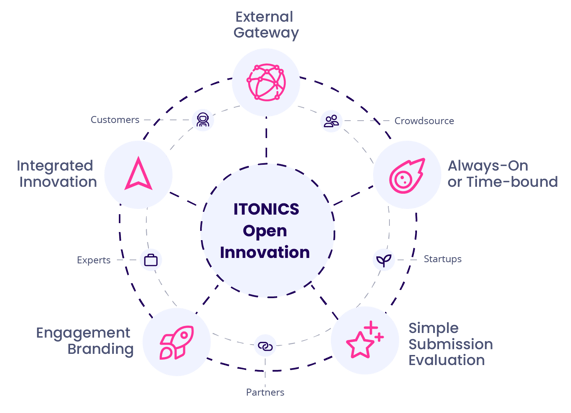It is clear that the challenges of this century, coupled with the complexities of a highly volatile market, call for new strategies and approaches. To unlock growth amidst crisis, organizations must draw on the vast pool of knowledge and ideas that exist beyond their own walls. As a technique, open innovation offers organizations the ability to generate many ideas from many different perspectives, aiding and accelerating solution discovery.
Today’s relevance for open innovation
By definition, open innovation represents a collaborative approach to innovation in which companies embrace co-creation and the exchange of internal and external knowledge. While the benefits of this technique are plentiful, the value of its application in our post-pandemic era is underscored by the following observations:
As the COVID-19 crisis unfolded, the world witnessed how response teams took an open approach to innovation, hoping that bidirectional flows of information and ideas would surface and accelerate solutions. Despite some of the devastating effects, digital tools and an openness to new business models enabled some organizations to flourish throughout the pandemic. With the lessons learned through this global event still in reach, innovators now have the opportunity to capitalize on open innovation as a proven technique in addressing the complex challenges this era presents.
According to McKinsey & Company, more than 90 percent of executives said they expect the reverberations of COVID-19 to fundamentally alter the way they do business over the next five years, with almost as many asserting that the crisis will have a lasting impact on their customers’ needs. Organizations must not only adapt to identify new customer demands but satisfy them with high-potential ideas so they can scale rapidly. Effectively implemented, open innovation has the potential to unlock potential and widen the space for intellectual exchange, ideation, and value creation.
Business continuity is being challenged by climate change, matters of inequality, economic uncertainty, and political instability. Today’s most pressing issues are global challenges that know no physical borders and cannot be tackled single-handedly. The ability to address increasingly urgent concerns about biodiversity, health, food security, and poverty depends on more effective innovation and new forms of international collaboration. The evolution of business requires inclusive input that aptly addresses these challenges and offers solutions that speak to a full ecosystem of stakeholders. Open innovation creates exceptional opportunities for organizations to break free of narrow internal perspectives, leveraging skills and knowledge that reside outside the business to offer more holistic solutions.
Driving growth with open innovation
It’s important to understand that the benefits of open innovation are not one-directional and limited to the organization's benefit. Instead, open innovation is about developing win-win solutions through collaboration and not about misappropriating intellectual value. When applied appropriately, the technique benefits all parties involved.
In the context of crisis—where systemic interventions are required, and true insights received directly from the ecosystem itself are invaluable—open innovation can unlock growth by:
- Mitigating unknown risks
- Providing access to external talent
- Surfacing synergies and rights to resources
- Creating adjacent, complementary revenue streams
- Arriving at disruptive, transformational opportunities
- Leveraging user insight for co-creation
- Reducing development costs, risks, and timelines
- Establishing competitive advantage
- Accelerating time-to-market
Open innovation with ITONICS
The ITONICS Innovation OS offers organizations a digital toolbox to empower innovation and enable efficient open innovation campaigns. This involves developing partnerships with third-party stakeholders such as vendors, suppliers, customers, startups, etc., and is contrary to traditional approaches to innovation that emphasize secrecy and a silo mentality. Illustrated below, there are several mechanisms on the platform that supports open innovation, each designed to speak to specific audiences and stakeholders.

In particular, the External Gateway holds notable value in designing open innovation campaigns to address post-crisis challenges. Most critical to the success of this use case, the ITONICS External Gateway enables you to leverage crowd knowledge and expertise from your clients, partners, and relevant communities.
The External Gateway is an external form that can be used to retrieve information from users outside of the organization. Presented as a landing page, the External Gateway form is made accessible for participants and contributors via a link. This link can be integrated into other sites and web pages, e.g. your company’s corporate website, as desired. The design of the External Gateway can be freely customized using HTML, CSS, and inline Javascript to match corporate branding and campaign design requirements. Fully configurable, this feature is most effectively used for open innovation challenges, crowdsourcing, or applications from startups and companies.
4 steps to set up an External Gateway in ITONICS
There are four simple steps application owners can take to set up the External Gateway to initiate a new open innovation campaign:
- Enable the external gateway for idea submissions
- Create and configure the external gateway
- Define and detail form fields
- Notify open innovation participants
1. Enable the external gateway for idea submissions
As a first step, application owners must enable the External Gateway module for the type of content the organization hopes to source through the open innovation campaign. Enabling the External Gateway flips the switch to say “Yes! We want to collect submissions.”
The ITONICS Innovation OS supports several types of content. Organizations can collect submissions for Ideas, Technologies, Trends, or Startups. Therefore, before initiating a campaign, you must identify what type of information you would like to collect. Once identified, the External Gateway can be enabled for this content type.
For instance, an organization may want to collect idea submissions to address a particular “How might we” design question focused on collecting submissions for post-crisis solutions. Therefore, in that case, the External Gateway must be enabled for the Ideas content type.
2. Create and configure the External Gateway
After enabling the External Gateway module, it is time to create and configure the External Gateway to be in line with the overall open innovation campaign requirements. This phase allows application owners the possibility to define the building blocks of the External Gateway. Editable elements such as the Gateway Name, URL, and form fields, to name a few, provide a basic structure for the form and determine the settings for its functionality.
In addition to this, the flexibility of the ITONICS platform also allows application owners to style the form according to specific design preferences. This enables the application owner to adhere to any specific company branding requirements to enhance the communication and success of the campaign.
3. Define and detail form fields
Once the initial configuration of the External Gateway is saved and created, the Form Configuration can be edited. This allows the application owner the means to define and detail which entry fields will be shown in the External Gateway form. These fields indicate the information the campaign aims to retrieve from participants. Once completed, the form can be saved and published to be shared with the selected audience.
4. Notify open innovation participants
Effective communication is a key factor for the success of any innovation campaign. For open innovation, it is particularly important to garner as many responses as possible through the campaign. Therefore, to begin with, it is essential to generate awareness and inform the targeted audience of the campaign. Thereafter, participants must be provided with clear guidelines and criteria to ensure the quality of their submissions. Finally, the campaign's outcome can be enhanced by keeping participants engaged at every stage of the selection process. Therefore, after successfully setting up your External Gateway, it is essential to determine specific touchpoints to incentivize participation and engagement at every phase of the process.
For that purpose, the ITONICS Innovation OS is designed to allow application owners to set up semi-automated notifications that are triggered by certain actions in a workflow. This ensures that specific messages can be sent at every phase in the submission and evaluation process. Consequently, these communication measures form the basis of building a community interested in the progress and development of solutions that meet the open innovation challenge.
To find out more about how ITONICS can help you to unlock the power of ideas and collaboration in your organization, get in touch with one of our experts and schedule a demo today.










